Holding out for My Hero: The Sega System 1
I promised you a deeper dive into the Sega System 1 arcade system in the Pitfall II article. And now we get it– let’s never say I don’t keep a non-zero fraction of my promises. We’ll also take a look at another System 1 game, My Hero, and look at how the game was ported to the Mark III/Sega Master System.
System 1
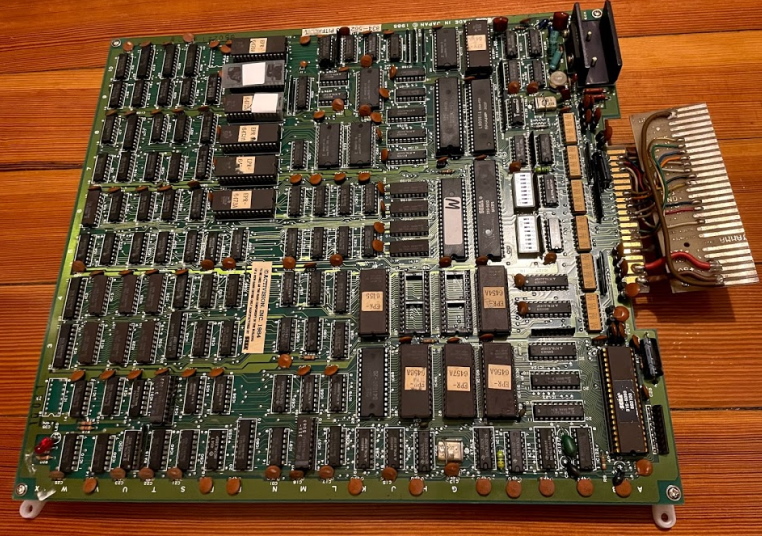
The Sega System 1 is a pretty large PCB. Originating in 1983, you can hardly blame it for not using the 1985 JAMMA standard, though Sega was pretty spotty at using JAMMA on its pre-JVS era boards. It’s a big board with a lot of discrete logic, but unlike the Alpha68k board we looked at, a lot of the graphics logic is also done in dedicated chips, like this Sega 315-5012. According to Sega Retro, this is a “sprite generator”.
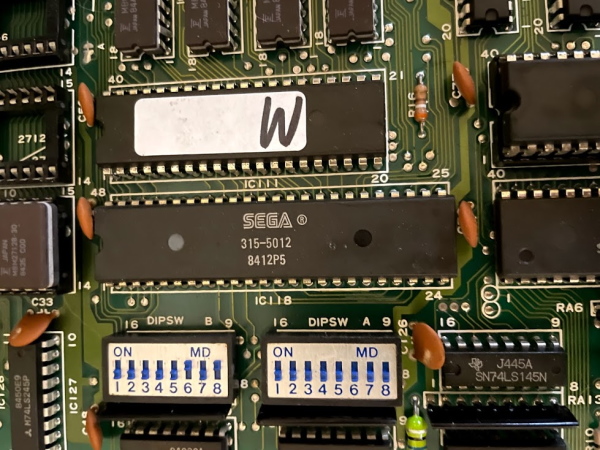
As you might expect from a board system from the 1980s, it’s powered by 8-bit processors. Specifically, main game logic is handled by a Zilog Z80 (well, in this case, an NEC clone, the D780C-1, but they’re equivalent), which Sega used in practically all their arcade boards. Music and sound are handled by a separate Zilog Z80, which communicates with the first over a single port on the Z80A-PIO chip, which is equivalent to the PIA you might find in 6502 world. (It seems some boards used an Intel equivalent instead)
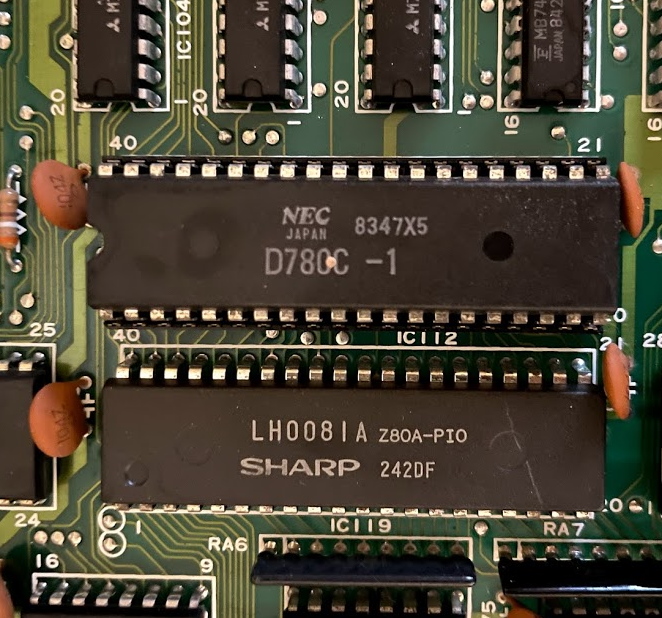
The combination of a sound CPU and a main CPU communicating over a single port might remind you of the Neo Geo; given that Alpha Denshi and Sega worked together in the System 1 period, you might wonder if they were taking notes. It is worth pointing out though that Alpha Denshi didn’t make any games using the System 1 hardware, preferring their own Equites hardware, which used a 68000 main CPU and an Intel 8085A sound CPU. Giving the sound responsibilities, which need to be real time, to a second CPU was in fact an incredibly common practice.
Graphics
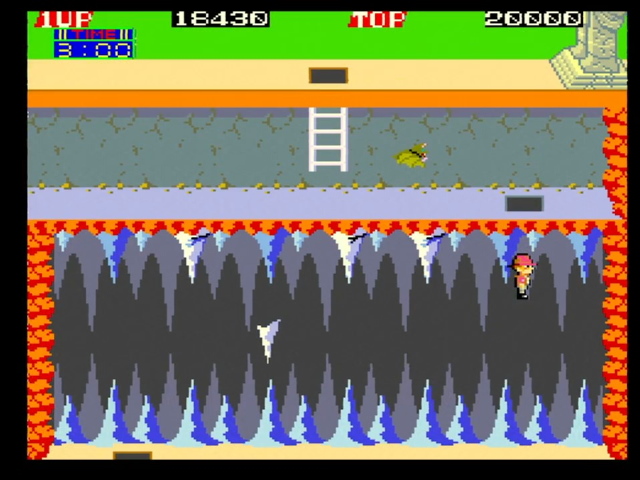
Pitfall II is a game that doesn’t need horizontal scrolling, but does use vertical scrolling. In the early 1980s, scrolling in general was becoming very important, as games moved beyond single-board games like Donkey Kong; the System 1 is distinguished from the later System 2 by having only two tilemaps; one fixed layer, and one for scrolling. Both are 32x32 grids of 8x8 tiles, giving you 256x256 pixels. (The System 2, used in games like Wonder Boy in Monster Land, expanded one of the two to a 64x64 grid) My source for all of this is the MAME source code, by the way.
256x256 is actually a pretty small tilemap; NES games are usually either 512x256 or 256x512, for comparison. (The Famicom came out in 1983, the same year as the System 1, and the latter is arcade hardware, so that’s a bit surprising) Let’s use MAME to illustrate how games use the scrolling tilemap. Let’s look at a screenshot of Pitfall II’s opening. Note that this is the raw screenshot, but since MAME often uses an odd internal resolution, I’ve doubled the height for your viewing pleasure. This means square pixels, but since we’re talking on a per-pixel basis, that should make things easier.
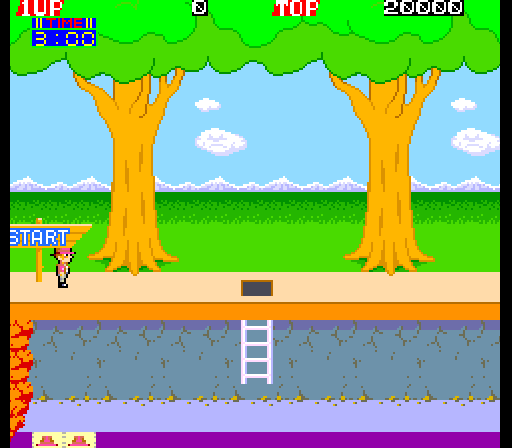
The raw screenshot is 512x224 pixels. Our score is zero, and if we assume the 16x8 tile is 8x8 internal tiles, a real resolution of the visible area is 256x224. However, 11 of those pixels, just over one tile, are taken up by the total area of the black bars on either side. For Pitfall II, that doesn’t really matter. We only need to scroll upwards and downwards, and with a 256-pixel high tilemap, it’s easy to change the tilemap in places that are off the screen.
But let’s now turn to the second game here, My Hero.
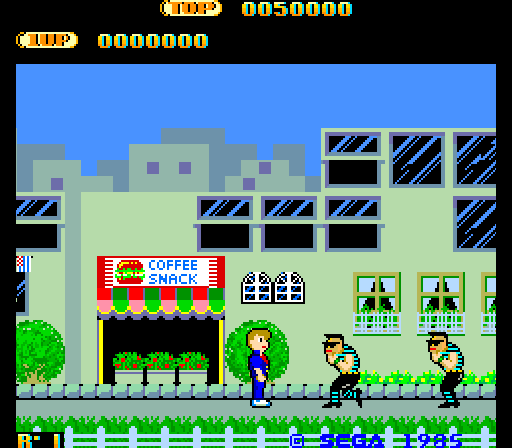
My Hero is a side-scroller, an early beat-em-up with more platforming elements than would eventually become typical in the genre. But the most important thing to remember is that we only have 256 pixels worth of horizontal tilemap. Notice that in some NES games like Super Pitfall, you can see a “seam” of glitched tiles on one side of the screen; Super Pitfall, an NES game with horizontal mirroring, has a 256x512 wide tilemap to work with.
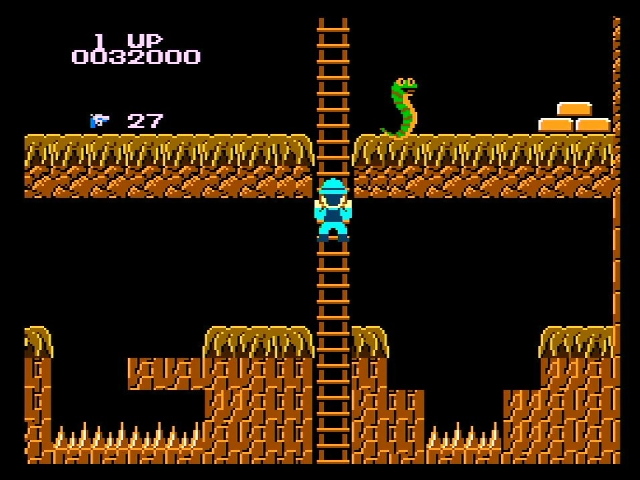
While Super Pitfall could’ve done better, if you have a 256-pixel wide tilemap, and a 256-pixel wide visible area, smoothly scrolling horizontally is going to be a problem for you. And that’s why the System 1 has those black bars. Sega gave up a little bit of horizontal resolution rather than include the additional RAM for a larger tilemap. The game developers really only need that small seam to work with to give smooth scrolling, especially with the main CPU not needing to handle sound and music, and therefore having plenty of time to update graphics. (In fact, My Hero has slightly larger mask bars on either side than Pitfall II)
The System 2, of course, would just give a larger tilemap, but many of its games still used black bars, or in some cases, colored bars like Wonder Boy in Monster Land. In fact, the last System 2 game, UFO Senshi Youko-chan, used black bars all around the screen, even though it used Zelda-style scrolling where the screen only scrolls when you pass over a screen edge.
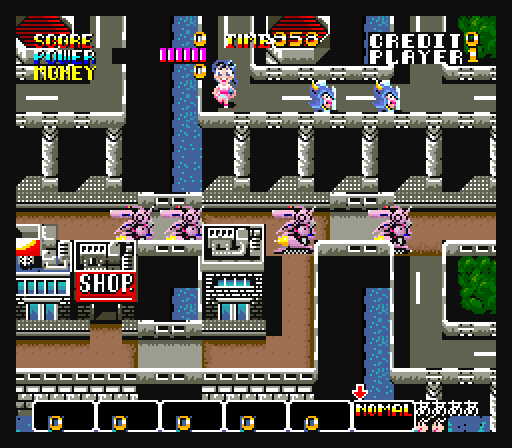
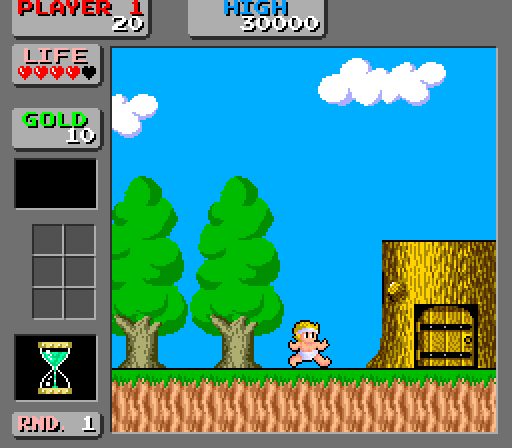
This sort of thing is much easier to see in emulators; an arcade operator would probably just adjust the CRT to hide the black bars as part of the horizontal overscan area. Therefore, it was a very easy tradeoff for developers to make; the NES did offer the ability to mask on the left side of the screen (but not the right), but the color attribute system using 16x16 areas meant that this couldn’t be entirely used to work around the problem.
In addition to the tilemap, the Sega System 1 offered hardware sprites and even hardware collision detection; there were 32 quite large sprites, and each had its own unique 16-color color palette. (Actually, 14 colors; one was used for transparency and one as a signaling bit determining the sprite’s width)
A neat thing about hardware collision detection is that it generally works by detecting overlapping pixels; therefore, it is “pixel-perfect”, rather than needing to use a bounding box. (But check out this article about fixing Atari’s E.T. for an example of how pixel-perfect collision is not always perfect; it’s fine in side-view platformers though) Unlike on the Master System, the System 1 also can tell the programmer which sprites collided, making it much more useful. An arcade board is much more expensive and can afford the extra memory.
Sound
You could be excused for missing the sound chips of the System 1; after all, they’re in tiny 16-pin DIP packages just like the sea of discrete logic chips that cover most of the board. But they’re there, right next to the amplifier (always recognizable; it’s where the heatsink is).
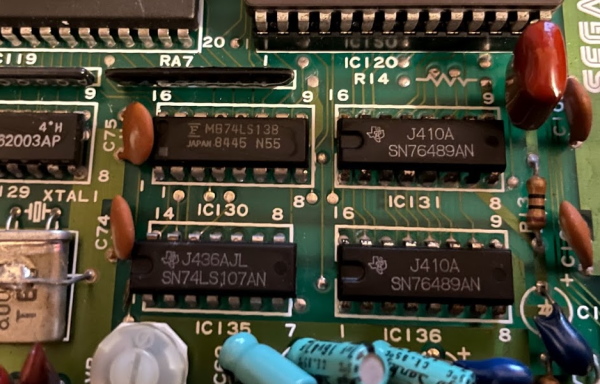
As befits a system with two identical CPUs, there are two identical sound chips: TI SN76489AN. This chip was designed for the TI-99/4A computer, and features three square waves and one noise channel. One of the square waves can be used to influence the noise channel, so they’re not completely independent.
The SN76489AN was used in a number of home machines, from the TI-99/4A to the ColecoVision and IBM PCjr; more importantly, it was used in Sega’s SG-1000 console and SC-3000. All of these systems, however, just used one; for the arcade, two were used, with a dedicated CPU for sound. This allowed for more complicated compositions.
Let’s take Pitfall II as an example. This is some random audio footage I took; notice also that while jumping doesn’t impact the tune, it does change when Pitfall Harry does his “Tarzan scream” at 27s.
Also note that despite having two chips, the audio is mono. I’m not sure what you’d get if you panned one SN76489AN to each ear, but I doubt it’d be that great. In general while this isn’t as flexible as, say, an FM synthesizer, they just weren’t on the market yet, and this did allow for more complex sounds than just one SN76489AN would. You can listen to this snippet from Pitfall II on SG-1000 for a comparison. It avoids having sound effects impact the theme by using only two channels for its audio, a heavy tradeoff to make.
Branding
In the article about the Alpha68k board, I talked about how some arcade boards, like the Sega ST-V and Neo Geo, were heavily branded as such, while others, like the Alpha-68k, were not. So where does the Sega System 1 come in?
As far as I can tell, the Sega System 1 and 2 brands were not customer-visible. An end-user didn’t get to know about them. But it seems that, at least in Japan, they were advertised to arcade board operators as a system. For example, look at this flyer for Teddy Boy Blues, a System 1 game that came out in 1985. See the green bar at the top?
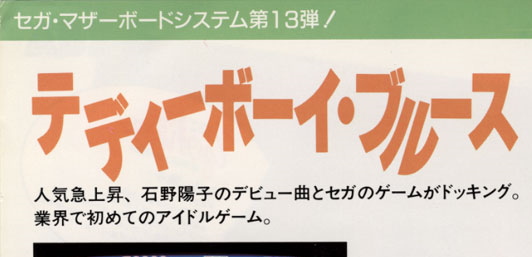
If you don’t speak Japanese, that says “Sega Motherboard System #13!”, which definitely seems to present it as part of a system. While American flyers aren’t as direct, we do see in the flyer for Flicky a promise of affordable conversion kits from Bally Midway, Sega’s American distributor. Remember that the System 1 is not JAMMA, so an arcade cabinet wired for it will only be easily converted to other System 1 games; but it predates JAMMA, so it’s hard to critcize for that.
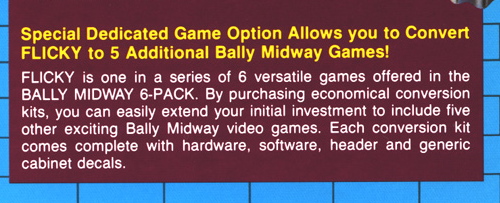
The term “Sega System 2” is used outright in the Japanese flyer for the 1986 game War Ball. I’m not sure if this makes “System 1” a retronym; “Sega Motherboard System” was maybe just too generic.
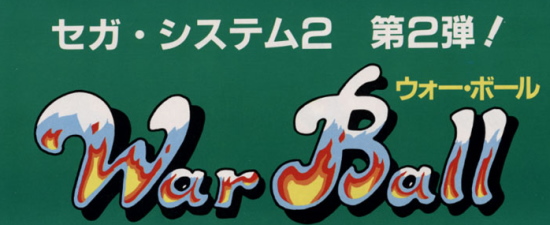
It’s always interesting to know where these names we give arcade boards come from, at least to me.
My Hero
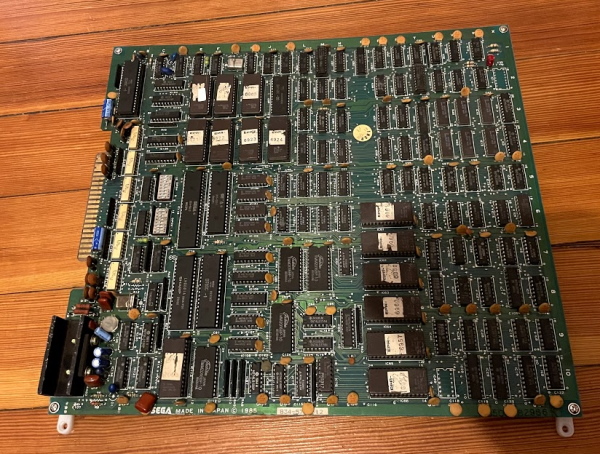
Here’s today’s game. My Hero is from 1986, by which point the System 1 had moved to a lower-end position in Sega’s lineup. Remember, Space Harrier came out in 1985, we were in the beginnings of the Super Scaler era. It was developed not by Sega but by Coreland, which would later become Banpresto, makers of the Super Robot Wars series. Coreland developed a number of System 1 games.

I’d like to give a shout-out to Phil Bennett for helping repair some corrosion on this board that had damaged its ability to play sound. Without his help, the board would sound like this: (warning, loud)
Which nobody would want. So thank you, Phil– you are truly My Hero’s hero.
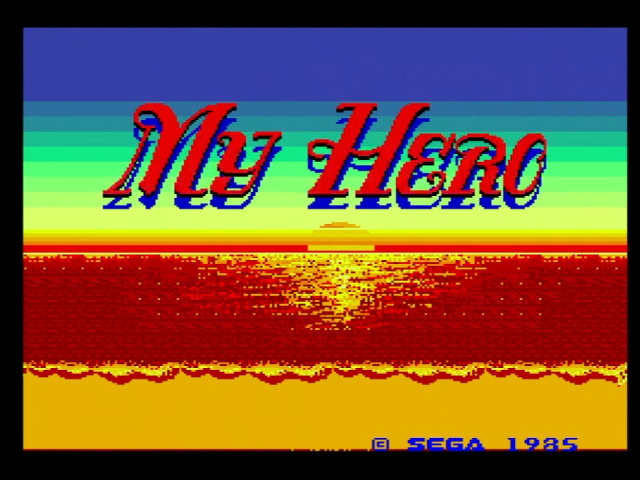
My Hero is the story of Stephen, who despite being a Kung Fu master, seems to have made an enemy of a gang of punks. They kidnap his girlfriend, Remy, in broad daylight, leaving him to fight through the whole world to get her back.
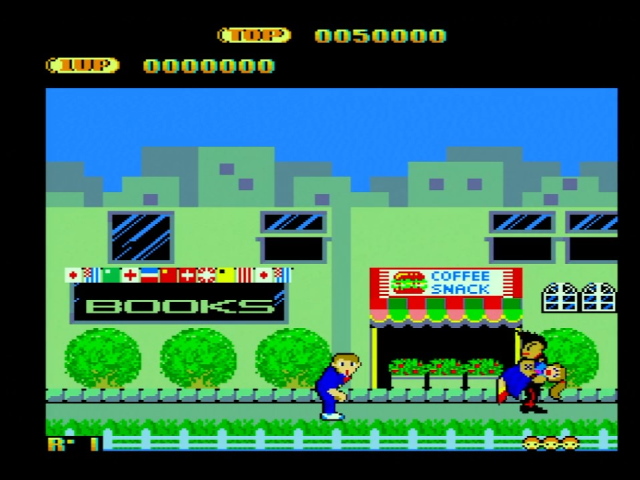
If you’re someone who looks at the world through the lens of North American NES launch titles, My Hero plays like a cross between Super Mario Bros. and Kung Fu. Stephen has two attacks, a punch, and a jumping kick. The kick is generally more useful; both attacks hit so hard that every enemy will get killed in one shot, flying off-screen as an angel.
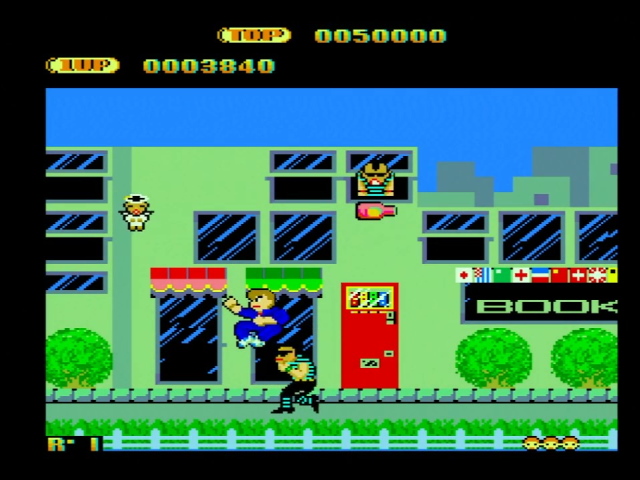
The catch is, Stephen will die just as easily to any of them. Thankfully, the game is pretty forgiving; like the Sega version of Pitfall II, you can start off pretty much right where you died. You can also find another captured fighter, who will fight alongside you if you can save him. He dies in one hit too, but hey.

The Super Mario Bros. influence comes in that each level also features platforming. You have to use Stephen’s jump-kick not only as an attack, but as a means to avoid bombs, fireballs, and various other attacks while jumping across. Generally, the more beat-em-up styled segments of levels are flat with many enemies, while the platformer segments have fewer enemies to kill.
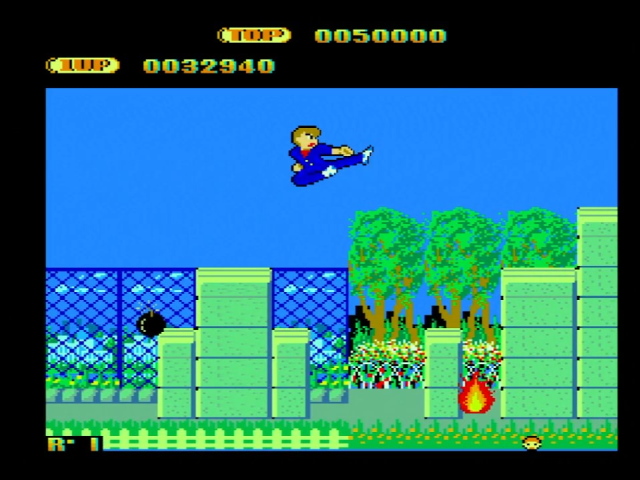
At the end of each level, you face off against the dastardly punk who stole your girl. The first boss is Mohican, named for his hairstyle. (In Japanese, “mohican” refers to the hairstyle that in American English is called a “mohawk”. Neither Native American tribe is actually believed to have used the hairstyle historically.) The boss fights are done with the same moves and controls, but in a one-on-one fighting game style against a beautiful sunset. Interestingly, you and your opponent’s “lifebars” go up the more hits you get on your opponent.
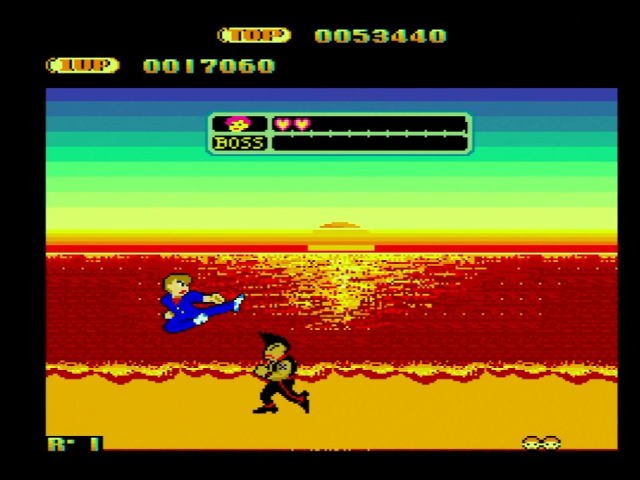
Following his victory, Stephen comforts and lectures his defeated foe. Though his dedication to being the better man is admirable, he really should pay more attention to the time portal that just opened next to him…
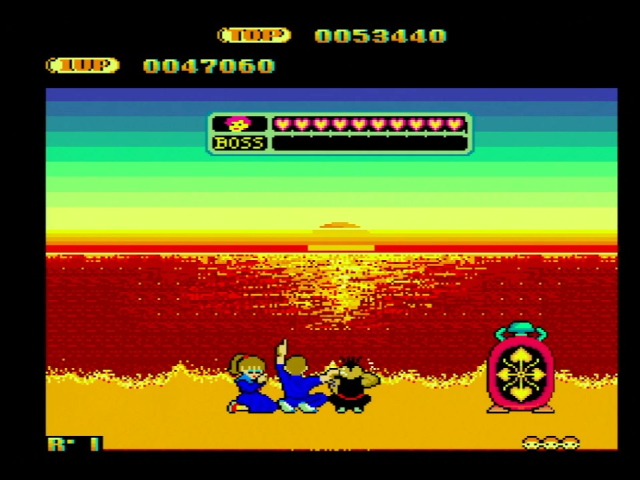
As a samurai shows up, steals Remy, and immediately runs off into the portal. The next level takes place in feudal Japan.
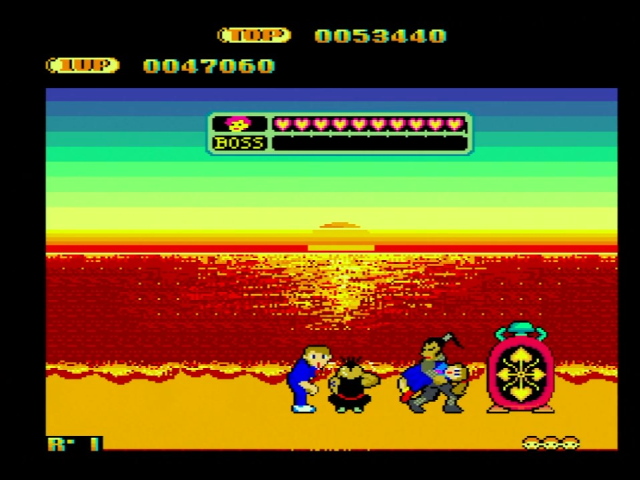

My Hero is an endless loop of a game; Remy can never actually be saved without some time traveler from the past or future, or Mohican himself, arriving to take her away. Like many arcade games of the time, it is primarily focused on score attack; though it also has the feature that you can not continue after going through a time portal.
Overall I’d say it’s quite fun. It’s definitely a quarter-muncher, but it motivates with just enough variety to keep it interesting and keep the quarters coming, and it doesn’t take itself too seriously. But there is a reason later beat ‘em ups would use lifebars.
My Hero makes the jump
So all of that hardware discussion aside, let’s take a look how at My Hero made the jump to the Master System, where it apparently gained a subtitle to become My Hero: The Sega Card. Joking of course, but the way Sega Cards were branded in the west really is a bit odd; I guess they hoped western gamers would be really excited by the small size of the cards.
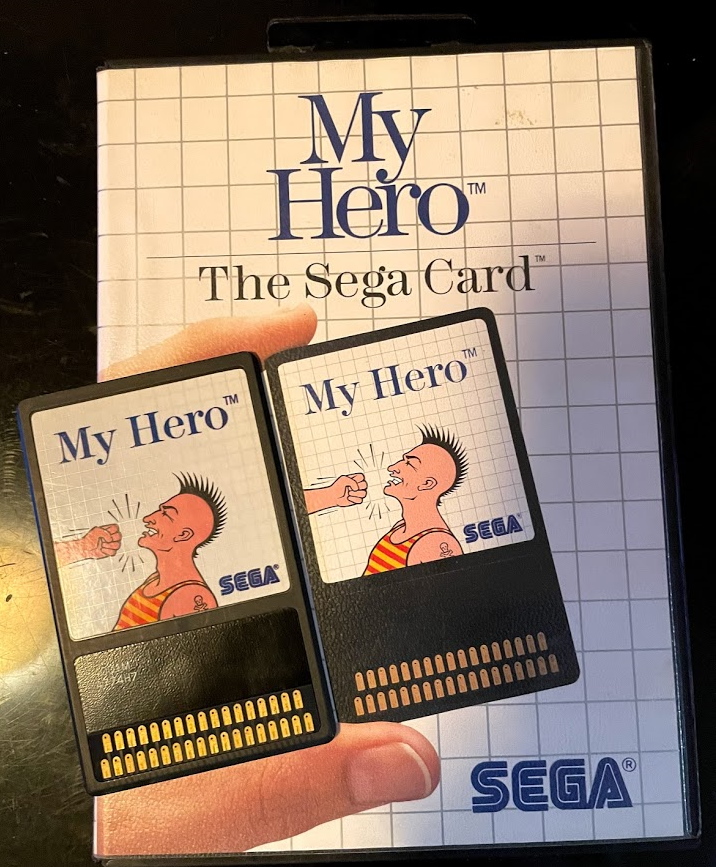
My Hero is pretty close to the Sega System 1 arcade version. You are a high school kung fu master out on a date, when your girlfriend is stolen right before your eyes by the punks. For some reason, the sky is now green.
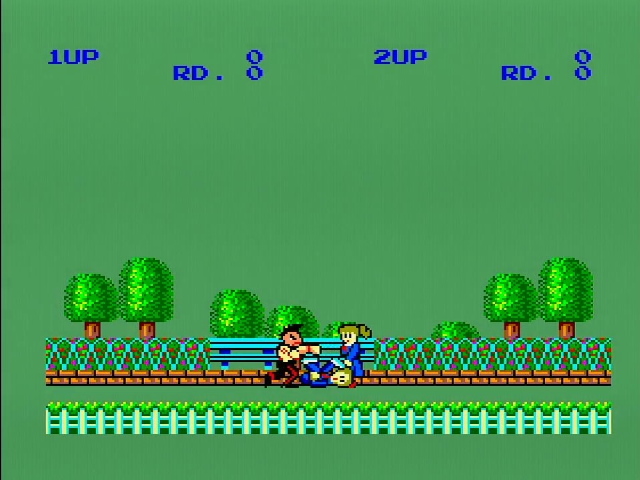
Notice one thing right on this opening cinematic. I have been taking these screenshots using capture cards that give a 16:9 output; then, I resize them to 480 pixels high, and crop them. There are no black borders here because the Master System colors its entire screen area the background color, so the whole visible area is colored.
Since the colored area is all from the console, you might notice that the image is slightly off-center. This is in fact the same reason as the black bars we saw in the arcade version; the Master System, like the NES, can avoid drawing the leftmost 8 pixels to allow for scrolling with a 256-pixel-wide tilemap. On the Master System, attributes are on each tile, so there are no 16x16 regions to worry about. These borders are pretty close to the overscan, looking at it on a CRT TV you really have to know it’s there to be able to tell.
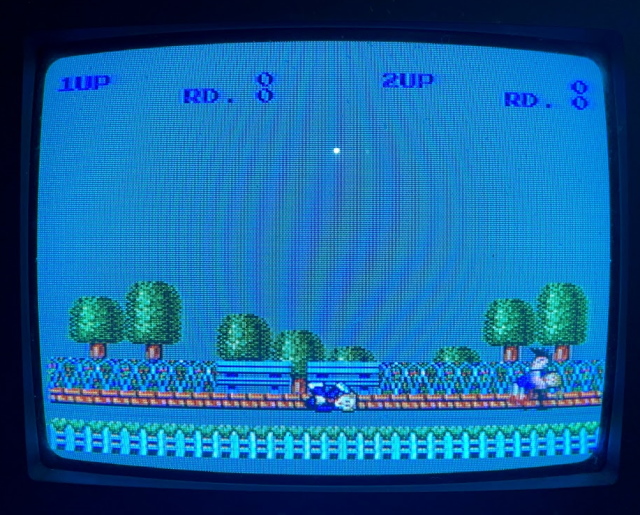
Huh, I just noticed that the background looks a lot more blue here. Unfortunately, that’s just a camera artifact; CRTs really are a pain to photograph. Both these screenshots were taken on Genesises using a Power Base Converter, though not the same Genesis. For whatever reason, I can’t get this card to boot on my Japanese Master System. The RGB screenshot was taken using an Open-Source Scan Converter on a Genesis 1, while the CRT was done using a Mega Drive 2 over composite. (And yes, the Mega Drive 2 manages to mangle even the PSG audio)
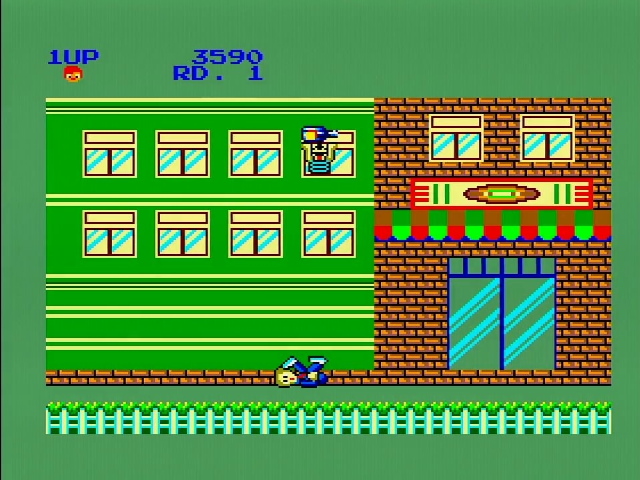
All My Card Are Belong To Sega
As noted, My Hero is on a “Sega Card”. The Sega Card, or My Card in Japan, apparently got its origin from Hideki Sato, Sega’s console designer, feeling that the black tall SG-1000 cartridges looked a bit too much like tombstones. And you have to admit the cards are much more appealing! (I wonder if the redesigned sideways cartridges the console used outside Japan are also due to this comparison)
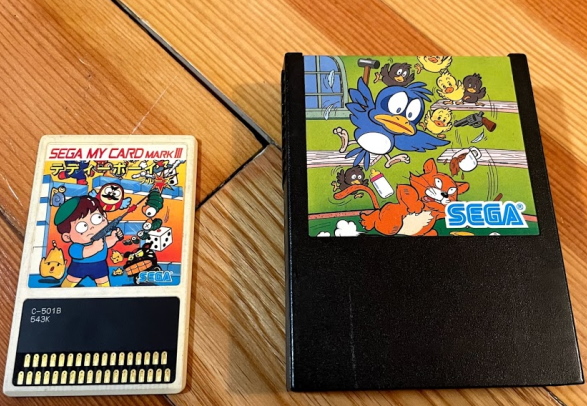
You might wonder what’s inside these cards; thankfully, I have a copy of Ghost House which has never worked as long as I’ve owned it, so I don’t mind tearing it apart.
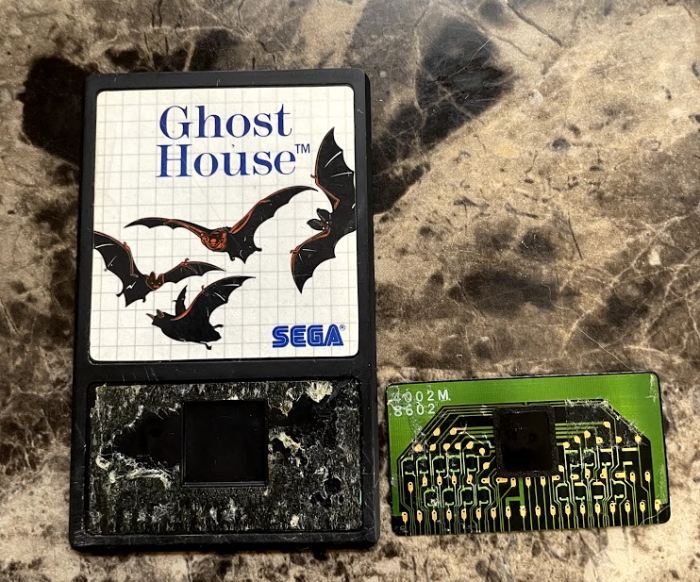
Most of the card is just a solid piece of plastic, which a small PCB is (quite thoroughly) glued to. That PCB basically just routes everything to a small black epoxy blob; this is the infamous “glop top” that would come to spread across electronics for low cost, but here it’s just to allow a smaller PCB.
Very similar card technology would go on to be used in the PC Engine HuCard; there, they would get no larger than 8 Megabits (1MiB). (Excluding Street Fighter II which used a larger PCB, and also exclude the Arcade Cards, which used RAM) Unfortunately, the My Card was much more limited than this; the card slot is only routed enough address lines to get 32kiB, or 0.25 megabits. On the PC Engine, memory mapping is handled on the console itself, but on the Mark III Sega would’ve needed to include that additional hardware on the card.
How limited is 32kiB? My NES game, Aspect Star “N” is, as of the last update, 24kiB: 16kiB program ROM and 8kiB character ROM. But the Sega Master System has a 16-bit graphics processor and its graphics are 4bpp (16 possible colors, including transparency or background). Therefore, 8kiB of 2bpp NES graphics would take twice as much space; so 32kiB on the SMS is really comparable to those smallest-possible NES games, ROM sizes used only on the earliest titles. Even Super Mario Bros. had 40kiB of ROM.
That being said, you can’t directly compare across consoles like this; those NES games had to have uncompressed graphics, since they didn’t use video RAM. The Master System always uses video RAM, so techniques like compression and storing graphics in lower quality can help use that space more efficiently. (There are in fact no uncompressed graphics at all in My Hero: The Sega Card) This also means there is no distinction between character ROM and program ROM, only program ROM.
Sega Cards were a bit of a flop, it seems; they weren’t supported on the later Master System 2, which wasn’t sold in Japan. One nice thing about the cards, though, is that the pinout is the same across regions. That means if your system doesn’t enforce region locks and supports cards, you should be able to play any card from any region.
My Hero, Interrupted
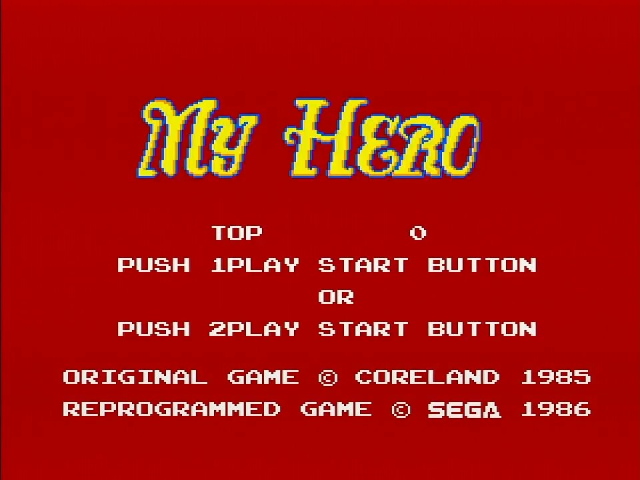
My Hero in the arcades had 168kiB of ROM. So dropping that down to 32kiB was going to take some sacrifices. The first thing you’ll probably notice is the reduced color depth and smaller sprites (while the Master System has 64 sprites, they are limited to 8x8 or 8x16 pixels in size, depending on mode), and less detailed backgrounds. This game really shows off the Sega Master System look of vibrant colors with little to no shading. (On the Master System, all sprites share a single 15-color palette, and a second 16-color palette can be used by the background) The setting is still recognizably modern Japan, but clearly redrawn from scratch.
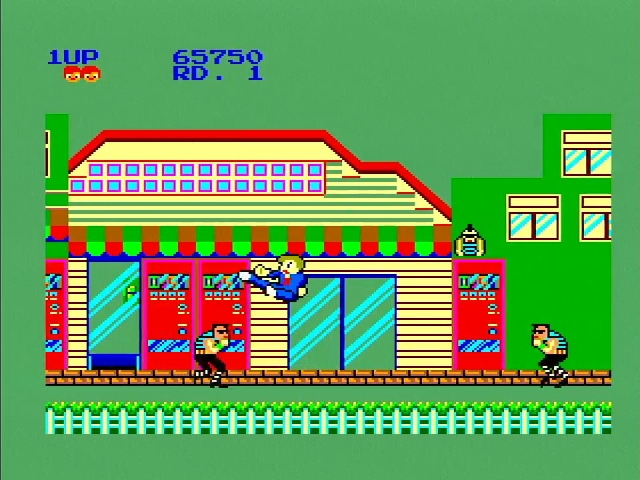
The next thing you’ll probably notice is that the game is a lot harder. Your punch, which was always less useful than the kick, seems to be even less useful, and the powerups, like getting another fighter, are missing. The enemies seem just as fast, though, and maybe even more numerous; it makes me wonder if this game is better in 50Hz. (However, at the time of this game’s making, it was almost certainly designed for 60Hz)
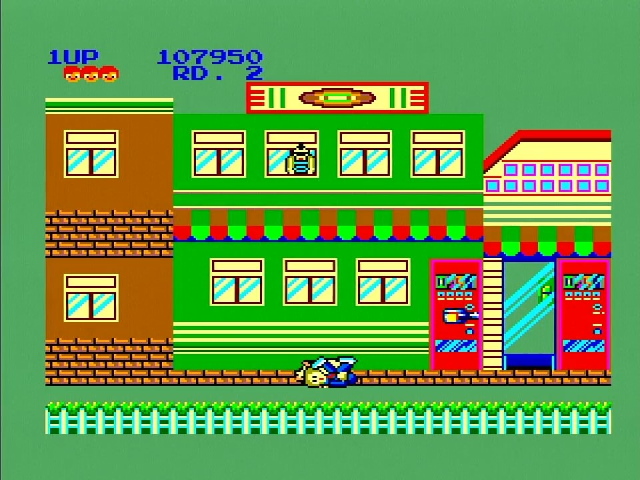
Still, the essence of the arcade game is definitely here. The level is divided into “beat ‘em up” and “platforming” segments, and Stephen moves like the arcade game. Even the end-of-level fight scenes are present, with the fighting game style one-on-one combat with lifebars., and even the sunset, which looks pretty good.
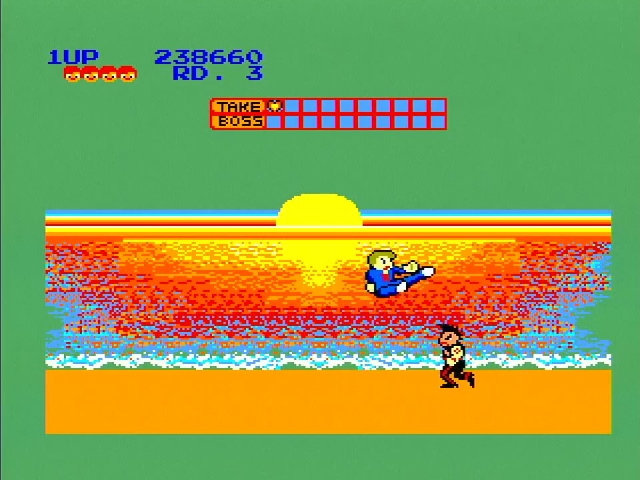
However, after beating Mohican, you’ll find no time portal in the fight scene. Instead, your defeated foe just gets right up and decides to kidnap Remy again. While My Hero on Sega Master System has three distinct levels, they all use the same tileset, with some differences in enemies, and in every case you fight Mohican at the end. Like the arcade version, the levels repeat infinitely, there is no end.
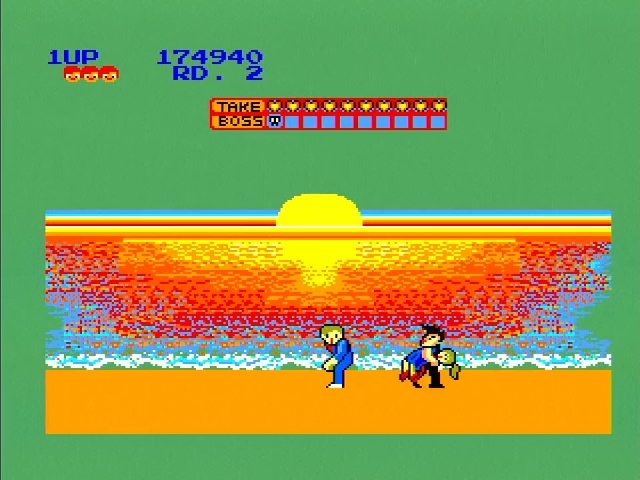
Overall, though the scope of the game is significantly reduced, it’s definitely a similar experience to the arcade, and keeps the essence of the gameplay. It’s fun to imagine a player who practiced heavily on this version, only to get to the arcade and finally beat the first level, only to get shocked by the presence of time travel. More likely, though, most people who played this game would never see it in the arcade at all.
Unfortunately, when the game was re-released on a cartridge, no efforts were made to expand the scope and insert elements that were removed; instead, it was a budget affair, keeping the identical 32kiB ROM. As far as I know, this is how all Sega Card games were moved to cartridge, many only in Europe or Brazil.
System 1 and Done
Sega’s System 1 era is to me really interesting; at the beginning of arcade machines designed for easy conversion kits, Sega and Coreland really put out a lot of interesting titles, from Western home games to political cartoons that surely had a pretty short shelf life. Of course, by this time arcade operators wanted to swap out games quickly, so that was no great loss. I imagine something like I’m Sorry is pretty hard to find in an original cabinet, as most out there were converted.
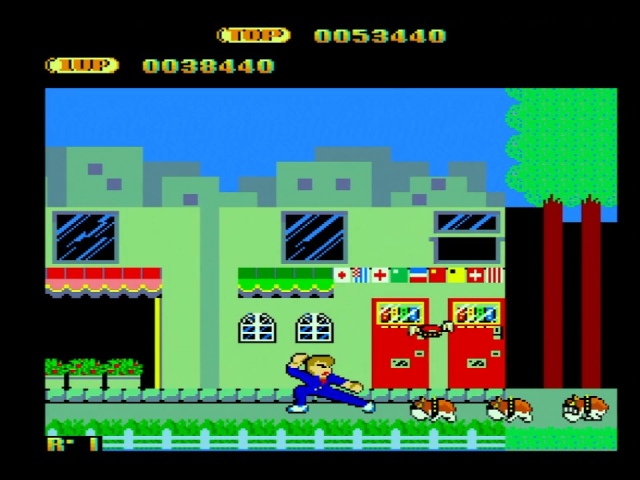
I’d like to say My Hero was a pioneering work that defined the later beat ‘em up genre, whose combination of jumping and attacking into a single mechanic would go on to inspire Sonic the Hedgehog. But I’m not sure any of that is true. In any case, though, it’s a fun game, and one I’m glad to have in my collection.
The Sega System 1 is an interesting platform, and I’m definitely going to keep my eye out for more boards of it. (Or even, once I have space, a cabinet) Honestly, if it was more accessible I might’ve tried my hand at making a game for it; however, instead, I think I may try my hand at the next best thing. Look out for more on that.
